Posted by · Leave a Comment
Okay, here goes.
There are two schools of thought on tail docking or removing the tail of a lamb. School # 1 says it’s not humane. I am not of this school. So, let’s move on to School # 2.
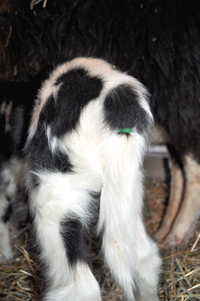
Tail with band applied
A Navajo-Churro lamb tail is very long at birth. If left alone, the tail as well as the wool in that area would collect poop. In warmer months, flies would swarm at the back-end of the animal and lay eggs. Maggots would, first, eat at the poop and then at the sheep. ‘Nuff said regarding “Flystrike.”
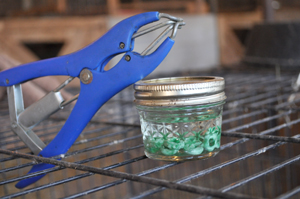
Elastrator and bands in jar of alcohol
So how to remove a tail as painlessly as possible? Two schools again. I’ll let you guess what School # 1 is so let’s move on to School # 2: the Elastrator or “band.”
It has taken me four years of lambing and, thus, banding to reach my conclusion that banding must be done on day two.
I believe the day a lamb is born is a critical day of bonding and allowing the lamb to get necessary colostrum from mom is very important—not to mention “finding its feet.”
Day Two, the lamb has filled out physically and by Day Three of life, I believe the tail has become thicker and, possibly, more sensitive.
Once, I unknowlingly waited for days before banding a pair and watched in horror as they both flopped around in pain. I cried, standing there helplessly, thinking I’d surely killed them both. They recovered; I never forgot. Therefore, I band on the second day of life and haven’t experienced another incident like that.
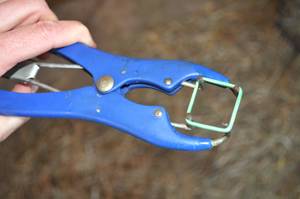
Elastrator and band
The banding tool stretches a thick green rubber band that allows one to travel up the tail, position, then release the band. I prefer to leave at least 1-1/2 inches of the tail and not go any higher than the two gentle folds of skin which are on the underside of the tail.
Believe me, the lamb realizes what has just occurred. However, the reaction I generally witness, if done at the “right” time, is a flurry of their tails as if trying to shake the band off (it usually falls off in one to three weeks). Almost 99 percent of the time, they go straight to mom’s udder and have a drink. Probably not a bad idea.

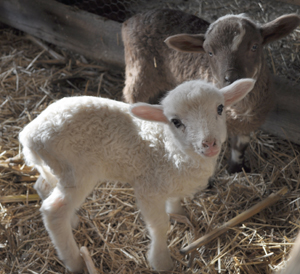
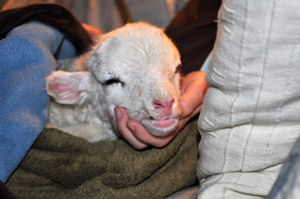 Yesterday, we brought him in the house. He appeared so weak and thin and cold all of a sudden; it’s amazing how quickly they can slide downhill.
Yesterday, we brought him in the house. He appeared so weak and thin and cold all of a sudden; it’s amazing how quickly they can slide downhill.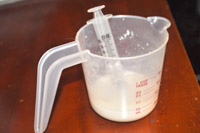 We placed him in a towel, under a heating blanket on “high” and held him for hours while giving him Purina’s “Kid Milk Replacer” with a syringe. It is a powder formula you mix with hot water– specifically for livestock babies.
We placed him in a towel, under a heating blanket on “high” and held him for hours while giving him Purina’s “Kid Milk Replacer” with a syringe. It is a powder formula you mix with hot water– specifically for livestock babies.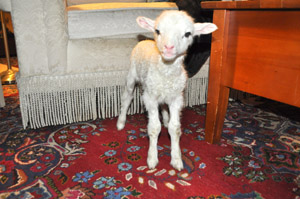 After five hours inside, offering replacer and warm water, he appeared a little more energetic so we took him back out to momma’s stall. She seemed genuinely happy to see him. Nevertheless, we’ll keep a watchful eye on him, keep the replacer coming at prescribed intervals (he drank a full “dose” this morning!) and, of course, bring him to cuddle on the couch….often.
After five hours inside, offering replacer and warm water, he appeared a little more energetic so we took him back out to momma’s stall. She seemed genuinely happy to see him. Nevertheless, we’ll keep a watchful eye on him, keep the replacer coming at prescribed intervals (he drank a full “dose” this morning!) and, of course, bring him to cuddle on the couch….often.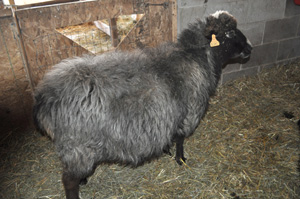
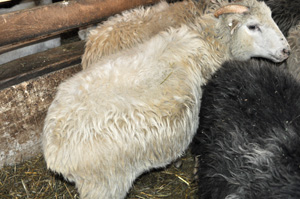
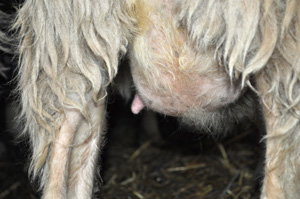
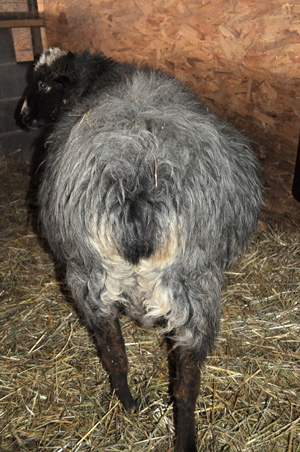
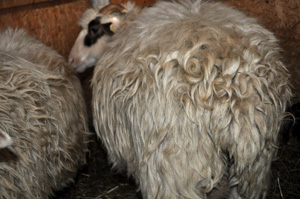
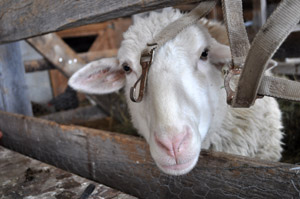
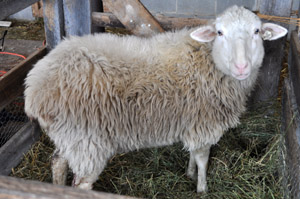
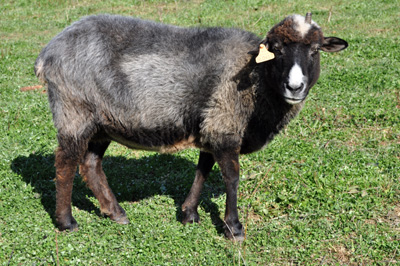 This is Reese, the matriarch of our flock. I took this picture because she was looking “fluffy.” Mind you, it’s not a word I use often when describing my sheep, but it seemed as though her coat had changed, almost overnight. She was sheared six weeks before so she already has over an inch of coat growth.
This is Reese, the matriarch of our flock. I took this picture because she was looking “fluffy.” Mind you, it’s not a word I use often when describing my sheep, but it seemed as though her coat had changed, almost overnight. She was sheared six weeks before so she already has over an inch of coat growth.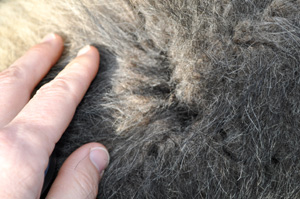

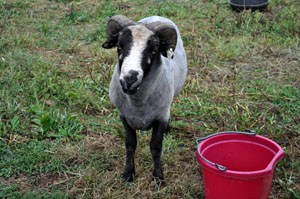 Baw Blue, our devilishly handsome Navajo-Churro ram will return to his home farm in a few days. We heeded his owner’s warning and gave him full and free access to the girls. (Translation: we did not venture into the pasture while he was here except for feeding and watering. Blue’s known to be quite territorial when it comes to his “girlfriends.”)
Baw Blue, our devilishly handsome Navajo-Churro ram will return to his home farm in a few days. We heeded his owner’s warning and gave him full and free access to the girls. (Translation: we did not venture into the pasture while he was here except for feeding and watering. Blue’s known to be quite territorial when it comes to his “girlfriends.”)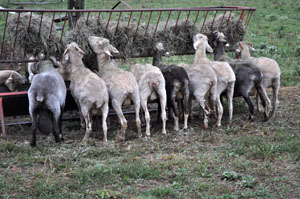
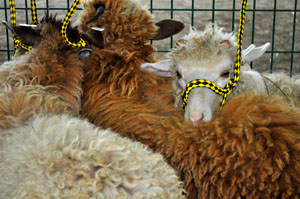 Rebecca Gunther, of
Rebecca Gunther, of 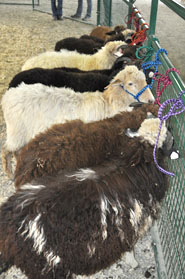
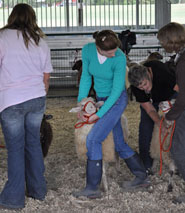
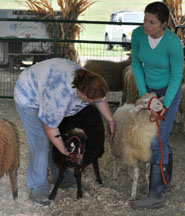 I was bound and determined NOT to let Oneida show ME up in the ring (after all, Ingrid was there!) so I kept her at my side with no slack in the lead and a hand firmly on the back of her neck and another cupping her jaw. Imagine my dismay, after Ingrid’s first few passes, when she asked me to move to one end of the line with Oneida. I had watched a few judgings before this and knew that the end where she was moving me was not where the winners had been repositioned. I probably had “rookie” stamped on my forehead! As beautiful and deserving as Oneida was, I was convinced I had done something as a handler to disqualify us. I was pretty sad.
I was bound and determined NOT to let Oneida show ME up in the ring (after all, Ingrid was there!) so I kept her at my side with no slack in the lead and a hand firmly on the back of her neck and another cupping her jaw. Imagine my dismay, after Ingrid’s first few passes, when she asked me to move to one end of the line with Oneida. I had watched a few judgings before this and knew that the end where she was moving me was not where the winners had been repositioned. I probably had “rookie” stamped on my forehead! As beautiful and deserving as Oneida was, I was convinced I had done something as a handler to disqualify us. I was pretty sad.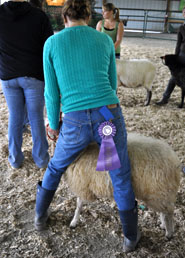
 Not only was this rookie wrong about the line-up, Oneida captured a blue-ribbon for her class and we went on to grab the Grand Reserve ribbon!! I couldn’t believe it! Well, it wasn’t “we” after all. Oneida is a one-of-a-kind Navajo-Churro and Ingrid validated that. However, I’d like to think my grip on that little girl that day ushered our chances right along in the ring.
Not only was this rookie wrong about the line-up, Oneida captured a blue-ribbon for her class and we went on to grab the Grand Reserve ribbon!! I couldn’t believe it! Well, it wasn’t “we” after all. Oneida is a one-of-a-kind Navajo-Churro and Ingrid validated that. However, I’d like to think my grip on that little girl that day ushered our chances right along in the ring.
